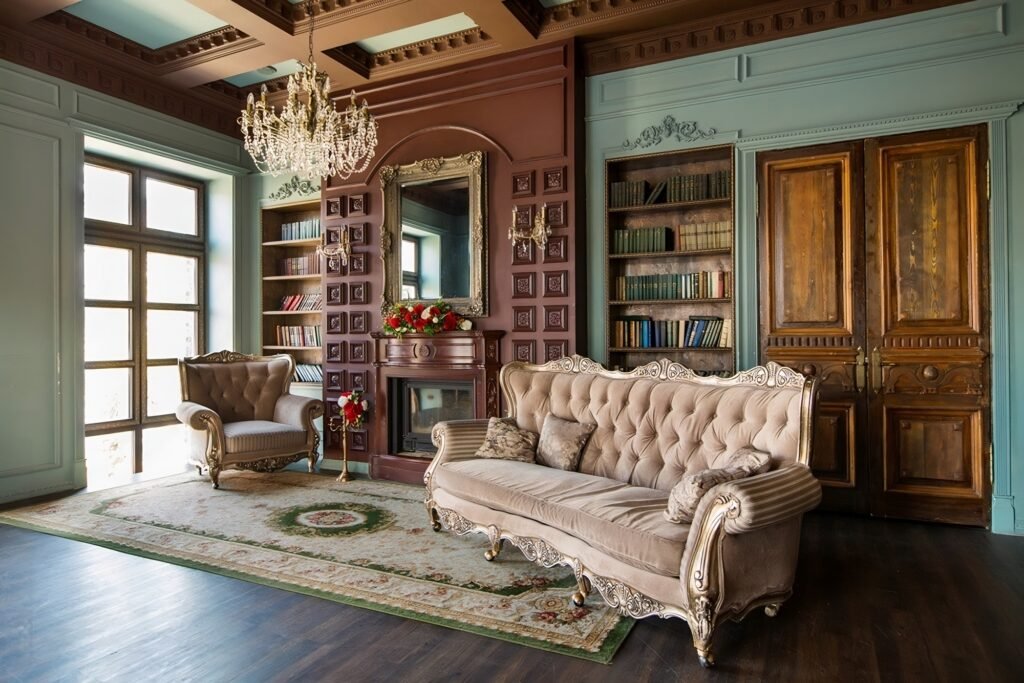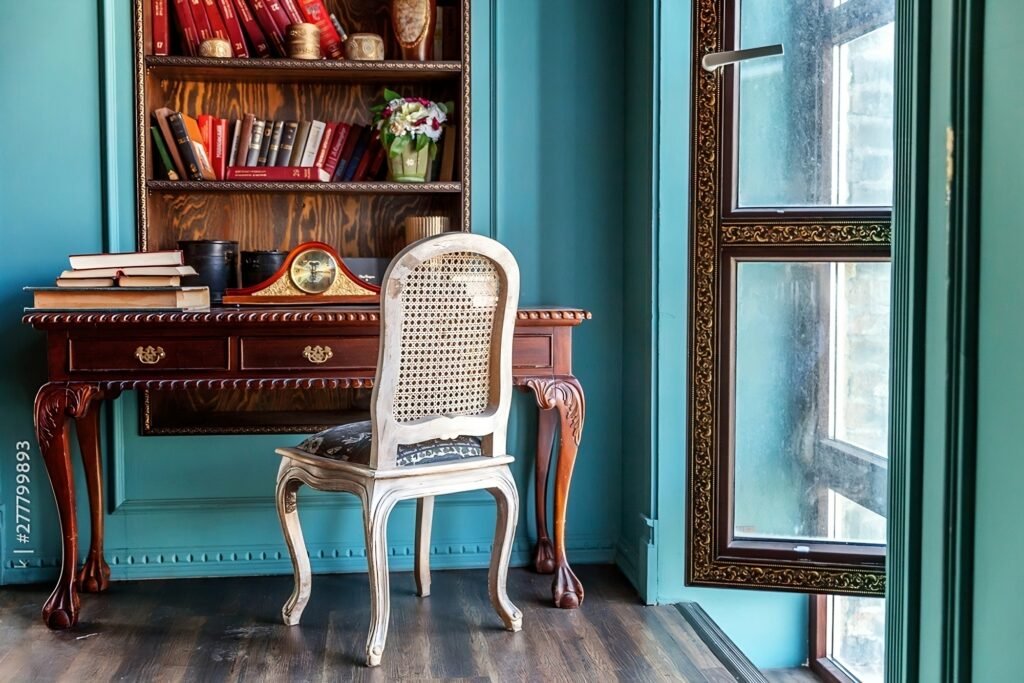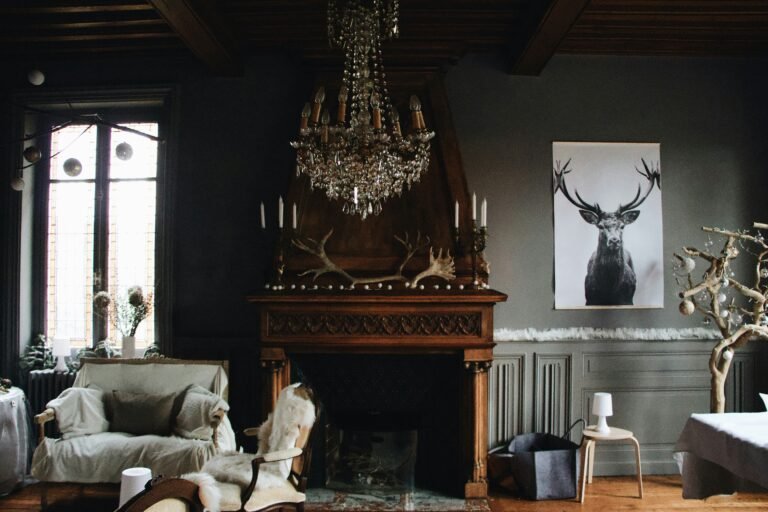I have always been fascinated by the way Victorian Style Interiors capture both grandeur and intimacy in a single glance. Walking into a room filled with rich wallpapers, carved wood, and glowing chandeliers instantly transports me to another era, an era that valued craftsmanship, ornamentation, and storytelling through design. Unlike minimalism, which thrives on restraint, Victorian style celebrates abundance: layered textures, ornate details, and bold expressions of taste.
In this guide, we will explore the history, key characteristics, and modern adaptations of Victorian interiors. You’ll learn how to bring timeless elegance into your own home, whether through statement furniture, wallpaper choices, or subtle décor touches. I’ll also share insights from my own experiences, showing how a carefully chosen antique or patterned rug can transform an otherwise ordinary space into something unforgettable.
Discovering the Origins of Victorian Style Interiors
The story of Victorian Style Interiors begins in the reign of Queen Victoria, from 1837 to 1901, a period marked by industrial innovation, colonial expansion, and the rise of a new middle class. With greater access to wealth and resources, homeowners expressed their status through design, filling their spaces with elaborate ornamentation and handcrafted details. According to Wikipedia’s overview of Victorian decorative arts, this era was a melting pot of influences, Gothic, Rococo, Renaissance, and even Eastern motifs found their way into parlors and drawing rooms.
What makes the Victorian period especially fascinating is its embrace of ornate details. Homes were often showcases of eclecticism, where patterned wallpapers coexisted with velvet upholstery, stained glass, and carved woodwork. I find this layering particularly inspiring because it reveals how interiors became a reflection of global trade, artistic revival movements, and the personal tastes of homeowners.
One cannot ignore the role of the Industrial Revolution. The rapid growth of manufacturing allowed mass production of wallpapers, tiles, and furniture, making once-exclusive luxuries accessible to a broader audience. As Chairish notes in their Victorian interior design guide, this democratization of design meant even modest homes could be adorned with patterned fabrics and intricate detailing, echoing the grandeur of aristocratic estates.
Yet despite this availability, craftsmanship remained at the heart of the style. Handmade carving, fine embroidery, and artisan glasswork set Victorian interiors apart from purely industrial products. This blend of machine-made accessibility and artisanal beauty created interiors that were not just lived in but deeply admired.
For me, researching the origins of Victorian design feels like stepping into a dialogue between past and present. The combination of timeless elegance and innovation shows us why the style continues to inspire decorators and homeowners today.
Key Defining Elements of Victorian Style
When we think of Victorian Style Interiors, the first images that come to mind are layers of richness: colors, textures, patterns, and furnishings that reflect both status and artistry. What makes this style enduring is not just its historical roots, but its adaptability to modern living. Let’s look at the essential components that define the look.
Rich Jewel Toned Color Palettes
Victorian interiors thrived on deep, dramatic hues. Think burgundy, emerald green, navy, and plum, often accented with touches of gold or cream. These palettes added gravitas to rooms, creating a sense of warmth and intimacy.
As Architectural Digest explains, the saturation of color was intentional, helping to offset dim lighting conditions of the 19th century. Today, homeowners can adapt these jewel tones by balancing them with lighter walls or ceilings, ensuring spaces feel elegant but not oppressive.
Ornate Details in Architecture and Furnishings
Carved wooden mantels, ceiling medallions, intricate cornices, and embossed wall coverings gave Victorian homes their unmistakable character. These ornate details often showcased craftsmanship and wealth, making interiors feel almost theatrical.
Even small additions such as a gilded mirror or decorative molding can add a Victorian flourish without overwhelming a modern room. I find that one carefully chosen detail, like a carved chair or an antique chandelier, can serve as a conversation starter while keeping the overall design approachable
Victorian Wallpaper Ideas
Pattern was everywhere in the Victorian home, but wallpaper was the ultimate design statement. Floral motifs, damasks, and even Gothic-inspired prints adorned walls in layered harmony. Designers like William Morris became icons of the era, with his botanical patterns still celebrated today (Victoria and Albert Museum).
For a contemporary take, I recommend using Victorian-inspired wallpaper as an accent—behind a bed, in a powder room, or on a feature wall. This allows the richness of the pattern to shine while keeping the overall effect modern.
Texture and Material Layers
Victorian interiors were tactile experiences. Velvet upholstery, brocade curtains, silk cushions, and carved wood came together to create depth. Marble, brass, and stained glass added both shine and contrast.
According to Better Homes & Gardens, layering is key to capturing the Victorian spirit today. Start with one or two luxurious fabrics, then add contrasting textures to keep the look dynamic.
Lighting and Statement Pieces
Gas lighting and later electricity allowed Victorians to experiment with elaborate fixtures. Chandeliers, stained glass lamps, and ornate sconces became focal points, illuminating interiors with drama and elegance.
Modern interpretations might include a crystal chandelier over a dining table or vintage-inspired sconces flanking a fireplace. I personally love how a single piece of lighting can transform a space, embodying both timeless elegance and practical function.
Room by Room Guide to Victorian Style Interiors
One of the reasons I admire Victorian design so much is its ability to adapt to different spaces while still feeling cohesive. Each room was treated as a stage for comfort, conversation, or display. Here’s how the principles of ornate details and timeless elegance unfold across the home.

The Parlor – A Showcase of Elegance
The Victorian parlor was the centerpiece of the home, designed to impress guests. Plush seating, carved wooden furniture, elaborate drapes, and layered rugs created a sense of grandeur.
A typical parlor would feature:
- A central fireplace with a marble or carved wood mantel
- Patterned wallpaper or rich wall coverings
- Heavy curtains with tassels and trims
- Conversation areas arranged around tables for tea or games
As Chairish notes in their Victorian style guide, the parlor was often where homeowners displayed their most prized possessions like art, porcelain, or family heirlooms. When I recreated a parlor-inspired corner in my own home, I found that adding one antique armchair and a patterned rug immediately evoked the spirit of Victorian hospitality.
The Dining Room – Ceremony and Hospitality
Victorian dining rooms were formal spaces meant for hosting. Heavy wooden tables, ornate chairs, and dramatic lighting set the stage for elegant meals.
Key elements included:
- Chandeliers or candelabras above the dining table
- Wainscoting or wood paneling paired with bold wallpaper
- China cabinets showcasing fine dishware
- Layered table settings with silver, crystal, and linens
According to Architectural Digest, dining rooms often incorporated Gothic or Renaissance influences, adding a ceremonial feel. Today, you can capture this spirit by pairing a vintage dining table with modern Victorian décor accents like velvet dining chairs or ornate mirrors.
The Hallway – First Impressions Matter
Hallways were more than just transitional spaces; they introduced visitors to the home’s style.
Common Victorian hallway features included:
- Encaustic or geometric tiled floors
- Staircases with carved balusters and newel posts
- Decorative mirrors and framed portraits
- Wallpaper combined with dado rails or wainscoting
Homebuilding & Renovating highlights that Victorian hallways were designed to impress, even in smaller homes. A checkerboard tile floor or patterned runner can bring this character to life in modern entryways. Personally, I think of hallways as opportunities. By adding a patterned floor tile in my own entry, I created a grand impression in a modest space
The Bathroom – Timeless Luxury
While bathrooms became more common in the late Victorian era, they reflected the same attention to detail as other rooms. Clawfoot tubs, pedestal sinks, and brass fixtures became staples of luxury.
For a modern interpretation:
- Install a freestanding clawfoot tub
- Use subway or encaustic tiles for flooring and walls
- Add a vintage-style mirror above a pedestal sink
- Incorporate ornate lighting like sconces or chandeliers
As Our Second Hand House notes, Victorian bathrooms celebrated comfort and indulgence. I love the way a clawfoot tub can transform a bathroom into a retreat, blending practicality with elegance.
Modern Adaptations of Victorian Interiors
While traditional Victorian Style Interiors were filled with elaborate patterns and heavy furnishings, many homeowners today prefer a lighter, more curated approach. That doesn’t mean abandoning the ornate beauty of the past, it means adapting it into something livable and fresh.
Modern Victorian Décor
Designers often use the term modern Victorian décor to describe a blend of historic charm with contemporary sensibilities. This approach allows jewel-toned fabrics, carved wood, and patterned wallpaper to shine against a backdrop of neutral walls and minimalist layouts.
As Better Homes & Gardens explains, the key is balance: a crystal chandelier in a dining room can feel contemporary when paired with streamlined furniture. Similarly, a William Morris–inspired wallpaper looks fresh when applied sparingly as an accent wall.
In my own home, I’ve found that mixing one or two Victorian antiques with modern pieces avoids the feeling of a period set. A carved armchair beside a sleek sofa, or a vintage lamp paired with a clean-lined console, creates an interior that feels layered and lived in.
The Cottage Revival
There’s also a renewed interest in Victorian cottage interiors, especially in rural settings. This revival is characterized by botanical prints, embroidered textiles, and cozy, storybook charm. Country Life highlights the restoration of Plum Cottage in Cornwall as a prime example, where authentic 19th-century décor has been given a modern yet nostalgic twist.
Cottage-inspired Victorian wallpaper ideas like leafy florals and climbing vines bring warmth and character without overpowering small spaces. Pair them with vintage wooden furniture and handmade quilts to achieve an inviting balance of practicality and romance.
Avoiding the Replica Trap
A word of caution: not all “Victorian-inspired” décor is created equal. Mass-produced replicas can sometimes feel forced or inauthentic. The Spruce warns against overusing faux-vintage pieces that lack craftsmanship.
Instead, I recommend investing in one or two authentic items, a true antique mirror, an heirloom rug, or a handcrafted chair. These pieces carry history, patina, and quality that replicas rarely achieve. Even in a modern space, a single authentic detail can anchor the entire design.
The Minimal Victorian Fusion
Some designers take a bold approach by pairing stark modern minimalism with ornate Victorian flourishes. A monochromatic room with a single ornate chandelier or a clean white bedroom accented by a carved wooden bedframe feels both striking and timeless.
This fusion is particularly appealing to me because it demonstrates how adaptable the style really is. By distilling the essence of ornate details and applying them sparingly, you get all the drama of Victorian style without the heaviness.
Practical Tips for Balancing Ornate Details and Comfort
One of the biggest challenges with Victorian Style Interiors is finding the sweet spot between richness and livability. Too many patterns or heavy furnishings can overwhelm, but too much restraint risks losing the character that makes the style so appealing. Over time, I’ve discovered a few strategies that allow you to enjoy ornate details while still keeping your home functional and inviting.

1. Start with Architectural Bones
If your home has original moldings, ceiling medallions, or a fireplace, highlight them. These authentic features are the foundation of the look. If not, consider adding reproduction crown molding or wainscoting for an instant Victorian touch. Redfin suggests focusing on these core details before layering furniture and décor.
2. Use Jewel Tones Strategically
Instead of painting every wall a dark shade, reserve bold colors for accent walls, upholstery, or rugs. This approach maintains depth without making rooms feel claustrophobic. Pairing jewel tones with lighter neutrals achieves timeless elegance while keeping the space balanced.
3. Layer Textures Thoughtfully
Victorians loved velvet, silk, and brocade but you don’t need to cover every surface. I recommend mixing one or two luxurious fabrics with simpler textures like cotton or linen. This layering gives dimension without overwhelming.
4. Mix Patterns with Care
The Victorians weren’t afraid of mixing florals, stripes, and damasks. For a modern interpretation, stick to two or three complementary patterns and vary their scale. For instance, pair a large floral wallpaper with a smaller striped pillow. Better Homes & Gardens suggests keeping to a consistent color palette for harmony.
5. Introduce Statement Lighting
A chandelier or vintage lamp is one of the simplest ways to add Victorian flair. Lighting naturally draws attention, making it an ideal way to integrate modern Victorian décor into contemporary spaces.
6. Balance Antique with Modern
Pairing a carved Victorian chair with a minimalist sofa or placing a gilded mirror above a modern console creates contrast and keeps the style from feeling dated. I’ve done this in my own living room, and the mix of eras sparks more conversation than any single design piece could.
7. Focus on Craftsmanship
Invest in authentic pieces where possible—hand-carved furniture, artisan glass, or genuine antiques. Chairish emphasizes the value of craftsmanship in Victorian interiors. Even one quality item can set the tone for an entire room.
8. Keep Clutter Curated
Victorian homes often brimmed with objects, but modern living benefits from editing. Choose meaningful items like a family heirloom, a vintage clock, or a framed portrait rather than filling every surface.
9. Use Rugs to Anchor Spaces
Oriental and Persian rugs are staples of Victorian décor. A richly patterned rug under a dining table or bed instantly grounds the space and adds warmth.
10. Maintain Functionality
Victorian design doesn’t have to mean impractical living. Ensure that hallways remain navigable, that lighting is sufficient for reading, and that seating is comfortable. A functional layout ensures that ornate beauty enhances rather than hinders everyday life.
Conclusion
Bringing Victorian Style Interiors into your home is less about recreating the past and more about capturing its spirit. At its heart, the style celebrates craftsmanship, ornate details, and layers of richness that tell a story. From jewel-toned palettes to patterned wallpapers, from statement lighting to carefully chosen antiques, every element works together to create a sense of timeless elegance.
For me, what makes Victorian interiors so inspiring is their adaptability. A single clawfoot tub, a chandelier, or even a floral accent wall can infuse your space with historic character without overwhelming modern living. I’ve learned that balance is everything—by mixing authentic pieces with contemporary comforts, your home becomes both beautiful and functional.
I encourage you to approach Victorian décor as a journey, not a formula. Whether you’re restoring a historic home or simply adding a touch of drama to a modern apartment, let your personality guide the process. That’s how the Victorians lived—with design as an expression of identity and taste.
In the end, the allure of Victorian interiors lies not in nostalgia but in their ability to remind us that beauty, detail, and artistry never go out of style.
FAQ: Victorian Style Interiors
Alex is the creator of Homely Haven, a space dedicated to simple, stylish ideas for interiors and gardens alike. With a passion for cozy living rooms, inviting outdoor spaces, and practical DIY solutions, Alex shares tips and guides that help turn any house into a true home.
From budget-friendly decorating hacks to weekend garden projects, the goal is always the same: to inspire you to create spaces that feel personal, beautiful, and welcoming. When not writing, Alex is usually rearranging furniture, sketching new garden layouts, or exploring design trends for the next project.








